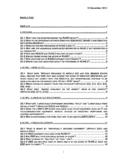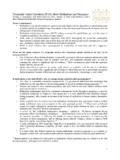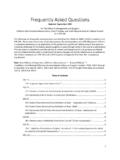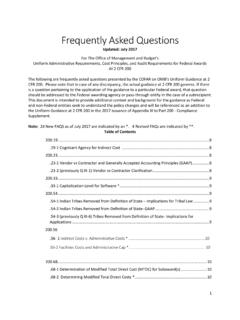Transcription of Frequently Asked Questions (FAQ) - Michigan
1 Frequently Asked Questions (FAQ) Plant Rehabilitation and Industrial Development Act (Industrial Facilities Exemption) (PA 198 of 1974, as amended) Version 8/21/2018 1 The following Frequently Asked Questions are being provided as a service to assessors and taxpayers to better inform them about the administration of Public Act 198 of 1974, MCL et seq., as amended. Note: The information contained in these Frequently Asked Questions constitutes an analysis of one or more statutes and not legal advice. Since the analysis is limited to general statutory requirements, individual facts may result in different conclusions being reached. Therefore, individuals may wish to consult legal counsel. 1. What is an Industrial Facilities Exemption? The Plant Rehabilitation and Industrial Development Districts Act, (known as the Industrial Facilities Exemption) PA 198 of 1974, as amended, provides a tax incentive to manufacturers to enable renovation and expansion of aging facilities, assist in the building of new facilities and to promote the establishment of high tech facilities.
2 An Industrial Development District (IDD) or a Plant Rehabilitation District (PRD) must be created prior to initiating a project so it is essential that you consult with your local assessor before commencing a project. An Industrial Facilities Exemption (IFE) certificate entitles the facility to exemption from ad valorem real and/or personal property taxes for a term of 1-12 years as determined by the local unit of government. Applications are filed, reviewed and approved by the local unit of government, but are also subject to review at the State level by the Property Services Division and the Michigan Economic Development Corporation. The State Tax Commission (STC) is ultimately responsible for final approval and issuance of certificates.
3 Exemptions are not effective until approved by the STC. 2. What is the difference between an Industrial Development District and a Plant Rehabilitation District? The main difference is that an Industrial Development District (IDD) covers only new facility projects and a Plant Rehabilitation District (PRD) is designed primarily for rehabilitation projects and requires a finding that 50% or more of the industrial property within the district is obsolete. (See MCL (5).) The 50% obsolescence requirement is measured by dividing the State Equalized Value (SEV) of the obsolete property by the SEV of all the properties in the district and multiplying the result by 100. 3. Should a Plant Rehabilitation District (PRD) include only the project that is currently being rehabilitated?
4 Yes. A PRD should only include the project that is currently being rehabilitated and requires at least 50% of the properties within the district to be obsolete. This allows future applicants the ability to apply for additional replacement facilities. In the case of a district which was created many years ago and encompassed many separate buildings, several separate Industrial Facilities Exemption Certificates could have been issued over the years. The result is that when the assessor calculates whether Frequently Asked Questions (FAQ) Plant Rehabilitation and Industrial Development Act (Industrial Facilities Exemption) (PA 198 of 1974, as amended) Version 8/21/2018 2 50% of the property in the district is obsolete, there may be so many new and rehabilitated properties that have returned to the ad valorem roll that the 50% obsolescence requirement cannot be met.
5 4. How do I identify the exact parameter of a project that will be placed within a Plant Rehabilitation District? The following procedure has been utilized to assist in identifying the exact parameter of the project that is being replaced and the taxable value to be frozen: a. Designate a PRD with a legal description that specifically matches the description of the replacement portion or project to be rehabilitated in the application. The legal description of the district will encompass only the building or portion of the building or machinery and equipment that is being rehabilitated. If the PRD includes more than the property currently being rehabilitated, an exemption certificate may be granted in the future to additional properties within the district even though the local unit objects to it.
6 B. Request that the assessor provide the Taxable Value (TV) of all the real and/or personal property contained within the boundaries of the specifically described PRD. This figure becomes the frozen TV of the facility. It has been the practice of the State Tax Commission (STC) to request that the SEV/TV of the entire PRD for a rehabilitation project be frozen. Many of the early applications involved projects in large established PRD districts where the SEVs of the entire PRD were later found to include additional buildings/personal property that were contained within the district and frozen but were not being rehabilitated at the time of the application. This was at times found to be detrimental to both the company and the local units.
7 The detriment for companies was that there was no allowance on frozen assessments for the depreciation of buildings and equipment. In order to correct the frozen assessment, the company would have to request revocation of the certificate. 5. Can a request to establish an Industrial Development District or a Plant Rehabilitation District be denied? Yes. A local governmental unit may approve or deny a request to establish a Once a district is established, a local unit cannot stop an application within the established district from being submitted, acted upon and given the full right to the appeal process. Frequently Asked Questions (FAQ) Plant Rehabilitation and Industrial Development Act (Industrial Facilities Exemption) (PA 198 of 1974, as amended) Version 8/21/2018 3 6.
8 Is there a procedure for dissolving an Industrial Development District or a Plant Rehabilitation District? Yes. Guidelines for the dissolving of a district can be found in MCL (8), which states the following: A local governmental unit, by resolution of its legislative body, may terminate a plant rehabilitation district or an industrial development district, if there are no industrial facility exemption certificates in effect in the plant rehabilitation district or the industrial development district on the date of the resolution to terminate. 7. How do I apply for an Industrial Facilities Exemption Certificate? An application for Industrial Facilities Exemption Certificate (Form 1012) can be found at the Michigan Department of Treasury website: File two copies of the completed application and all attachments with the clerk of the local governmental unit where the facility is located.
9 You must meet the following qualifications of the Act: a. The facility must be located within an established Industrial Development or Plant Rehabilitation District; b. The applicant is a qualifying business as outlined in MCL ; and c. The application for the exemption can be prefiled but must be filed within six months of the commencement of the improvements. 8. Are there provisions in the application process that are time sensitive? Yes. There are several provisions which cause the application process to be time-sensitive. MCL (8)(b) provides that a speculative building must be one that is constructed before a specific user is identified. MCL (3) requires that the request for the establishment of a proposed Plant Rehabilitation District (PRD) or Industrial Development District (IDD) must be made prior to the start of construction of the property for which exemption is being sought.
10 MCL (4) requires that before adopting a resolution establishing a PRD or IDD the legislative body shall give written notice by certified mail to the owners Frequently Asked Questions (FAQ) Plant Rehabilitation and Industrial Development Act (Industrial Facilities Exemption) (PA 198 of 1974, as amended) Version 8/21/2018 4 of all real property within the proposed PRD or IDD, hold a public hearing on the proposed establishment, and grant a right to appear and be heard regarding same. MCL (9) provides that before acting on a proposed resolution terminating a PRD or IDD, the local unit shall give at least 14 days written notice by certified mail to owners of all real property within the PRD or IDD and hold a hearing at which those owners have a right to appear and be heard. MCL (2) requires that before acting upon an application, the legislative body of the local governmental unit shall afford the applicant, the assessor and a representative of the affected taxing units an opportunity for a hearing.



















